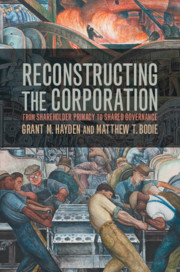24 results
Acknowledgments
-
- Book:
- Reconstructing the Corporation
- Published online:
- 18 February 2021
- Print publication:
- 11 March 2021, pp xii-xiv
-
- Chapter
- Export citation
Copyright page
-
- Book:
- Reconstructing the Corporation
- Published online:
- 18 February 2021
- Print publication:
- 11 March 2021, pp iv-iv
-
- Chapter
- Export citation
11 - The German Codetermination Experience
-
- Book:
- Reconstructing the Corporation
- Published online:
- 18 February 2021
- Print publication:
- 11 March 2021, pp 172-183
-
- Chapter
- Export citation
5 - Shareholder Homogeneity
-
- Book:
- Reconstructing the Corporation
- Published online:
- 18 February 2021
- Print publication:
- 11 March 2021, pp 68-87
-
- Chapter
- Export citation
1 - Introduction
-
- Book:
- Reconstructing the Corporation
- Published online:
- 18 February 2021
- Print publication:
- 11 March 2021, pp 1-14
-
- Chapter
- Export citation
10 - Democratic Participation and Shared Governance
-
- Book:
- Reconstructing the Corporation
- Published online:
- 18 February 2021
- Print publication:
- 11 March 2021, pp 161-171
-
- Chapter
- Export citation
9 - A Firm-Based Approach to Corporate Voting Rights
-
- Book:
- Reconstructing the Corporation
- Published online:
- 18 February 2021
- Print publication:
- 11 March 2021, pp 145-160
-
- Chapter
- Export citation
2 - Preference Aggregation in Political Institutions
-
- Book:
- Reconstructing the Corporation
- Published online:
- 18 February 2021
- Print publication:
- 11 March 2021, pp 15-29
-
- Chapter
- Export citation
8 - The Shareholder Franchise and Board Primacy
-
- Book:
- Reconstructing the Corporation
- Published online:
- 18 February 2021
- Print publication:
- 11 March 2021, pp 122-144
-
- Chapter
- Export citation
6 - The Argument from the Residual
-
- Book:
- Reconstructing the Corporation
- Published online:
- 18 February 2021
- Print publication:
- 11 March 2021, pp 88-102
-
- Chapter
- Export citation
Notes
-
- Book:
- Reconstructing the Corporation
- Published online:
- 18 February 2021
- Print publication:
- 11 March 2021, pp 189-259
-
- Chapter
- Export citation
Index
-
- Book:
- Reconstructing the Corporation
- Published online:
- 18 February 2021
- Print publication:
- 11 March 2021, pp 260-274
-
- Chapter
- Export citation
3 - Preference Aggregation in Corporations
-
- Book:
- Reconstructing the Corporation
- Published online:
- 18 February 2021
- Print publication:
- 11 March 2021, pp 30-49
-
- Chapter
- Export citation
Preface
-
- Book:
- Reconstructing the Corporation
- Published online:
- 18 February 2021
- Print publication:
- 11 March 2021, pp ix-xi
-
- Chapter
- Export citation
Contents
-
- Book:
- Reconstructing the Corporation
- Published online:
- 18 February 2021
- Print publication:
- 11 March 2021, pp vii-viii
-
- Chapter
- Export citation
Dedication
-
- Book:
- Reconstructing the Corporation
- Published online:
- 18 February 2021
- Print publication:
- 11 March 2021, pp v-vi
-
- Chapter
- Export citation
4 - The Corporation as Contract
-
- Book:
- Reconstructing the Corporation
- Published online:
- 18 February 2021
- Print publication:
- 11 March 2021, pp 50-67
-
- Chapter
- Export citation
7 - The Argument from Arrow’s Theorem
-
- Book:
- Reconstructing the Corporation
- Published online:
- 18 February 2021
- Print publication:
- 11 March 2021, pp 103-121
-
- Chapter
- Export citation
12 - Conclusion
-
- Book:
- Reconstructing the Corporation
- Published online:
- 18 February 2021
- Print publication:
- 11 March 2021, pp 184-188
-
- Chapter
- Export citation

Reconstructing the Corporation
- From Shareholder Primacy to Shared Governance
-
- Published online:
- 18 February 2021
- Print publication:
- 11 March 2021



